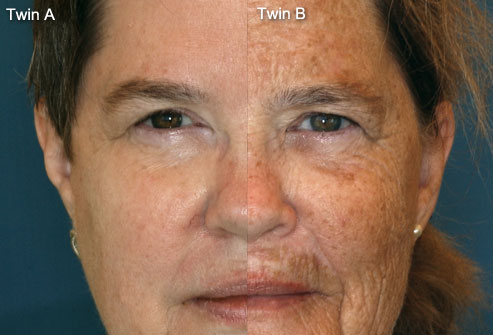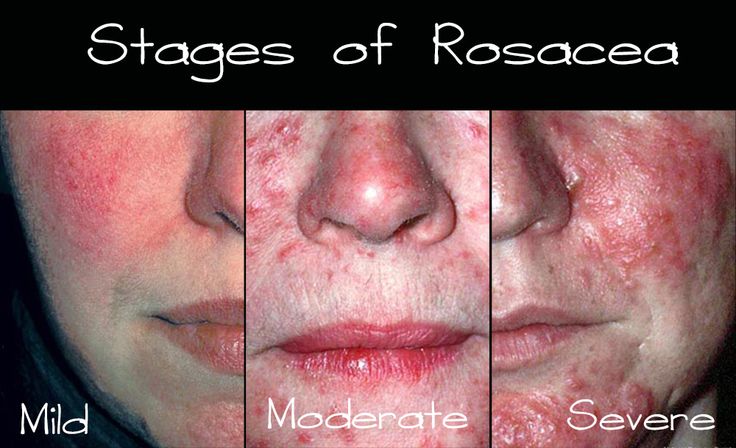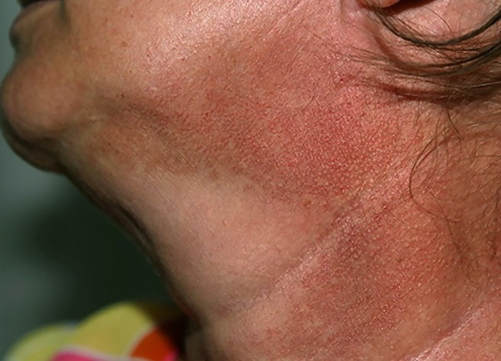Aging of skin colour affected by
- Sun damage
- Smoking
- Genetics: thank your parents!
- Diet
- Occupation
- Underlying diseases
- Drugs and alcohol
"Well, the last time I had a picture taken I could hardly see my eyes because of the weight of heavy eyelid. Then I paid attention to how I was actually using my eyes and I really noticed when I was looking at anything especially the computer I was straining my forehead to see better. Since I have had it done I no longer have to lift the forehead and tilt my head to see. It is amazing! I love..." D. Rock 63 Yrs Old with Fat Droopy Eyes - Salt Lake City, UT
how does skin colour affect us?
Skin colour is so vital that it deserves a separate discussion from the other aging changes of the skin. The smooth, unblemished, youthful skin is always overtaken by changes in colour: these will be caused by pigmented spots, white spots, vessels, generalized pinkness, and irregular pigmentation associated with life-long sun-related damage.
Although these changes are most obvious on the face, they are also seen on the neck, the chest and arms, hands and legs. Indeed, even covered areas like backs and abdomens will show some of these changes.
Acne rosacea becomes more pronounced as we age, resulting in “pink cheeks” with prominent vessels. Acne is best known as the scourge of teens, and to a lesser degree adults. But, it’s entirely possible that what you think is adult may actually be rosacea. Rosacea is NOT true acne.
Although these changes are most obvious on the face, they are also seen on the neck, the chest and arms, hands and legs. Indeed, even covered areas like backs and abdomens will show some of these changes.
Acne rosacea becomes more pronounced as we age, resulting in “pink cheeks” with prominent vessels. Acne is best known as the scourge of teens, and to a lesser degree adults. But, it’s entirely possible that what you think is adult may actually be rosacea. Rosacea is NOT true acne.
What exactly is rosacea?
In general, rosacea causes redness and pimples in the central face. About 14 million Americans
have it. Rosacea occurs more often in women, most commonly among those ages 30-50.
have it. Rosacea occurs more often in women, most commonly among those ages 30-50.
Who’s most at risk for rosacea?
Acne rosacea is seen most frequently among those who are fair-skinned, from Celtic or Scandinavian descent and had bad acne as a teen. It also tends to run in families and in women who blush or flush easily. It is believed that flushing increases the skin’s temperature where bacteria can grow. Rosacea may be a reaction to these germs although this is contentious. Many treatments for rosacea are medications that suppress bacteria or decrease the reaction to bacteria.Because flushing is more likely after drinking a hot beverage or getting overheated, flushing can be avoided by sipping a cool beverage or sucking on ice chips.
Adult acne vs. rosacea
Acne results when the skin’s pores become plugged, which traps oil where acne bacteria live. Treatment leans toward self-care with over-the-counter cleansers, lotions, creams and other medications.
Is it acne or rosacea?
Poikiloderma of Civatte is the change seen on the side of the neck caused by chronic sun
exposure: there is a combination of pigmentation and reticular vascularization giving a motley appearance to the skin.
exposure: there is a combination of pigmentation and reticular vascularization giving a motley appearance to the skin.
Similarly, women often develop fine vessels in the alar grooves (sides of the nose).
Treatment Options |
Pigmentary and vascular changes are particularly common and worse on the neck and the chest as many forget to protect these areas with appropriate sunscreens
|
"I had a excellent eye lift done by Dr. Patel. He knows what he is doing and is very pleasant. Dr.Patel was easy to get an appointment and he works with you. The office staff was very pleasant and made you feel calm." D. Gull Highly recommended for eye lift surgery - Salt Lake City, UT
Schedule Your Consult Today |
|
Visit Patel Plastic Surgery on YouTube for more free tips!
Stay Connected With Us On Social Media
|
Find UsLocations:
Dr. BCK Patel MD, FRCS 1025E 3300S Salt Lake City, Utah 84106, USA (801) 413-3599 (phone/text) E: [email protected] bckpatel.info Dr. BCK Patel MD, FRCS 585 E Riverside Dr Suite 201 Saint George, UT 84790 (435) 215-0014 E: [email protected] Quick-Link |
Let Us answer your questions |













